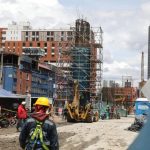There is 195 countries in the world. A little more than 200 if we look at other countries criteria. Scattered across the more than 149 million square kilometers that make up the land area of our planet, we have truly unique countries and territories with very singular characteristics. However, in all that expanse and with so many countries, only one is in all four hemispheres.
This is the Republic of Kiribati, a group of islands with a peculiar history and a not very promising future: it is in serious danger due to climate change.
Changing hands. Kiribati is one country, but it is really a set The islands are made up of 33 atolls (coral island formations) and one volcanic island in the middle of the Pacific. Some of them are close and others are far away, and although their ‘terrestrial’ dimensions are small (barely 800 square kilometres), they occupy a territory of three million square kilometres. Some islands were populated by groups from Micronesia who, over the centuries, mixed with other civilisations such as the Polynesian and Melanesian.
However, the Spanish and Portuguese arrived in the 16th century and ruled the islands until 1885. Things changed when the British arrived and, like the British Museum, took over the islands in 1892. From then on, things were quite eventful: in World War II, the Japanese occupied Tarawa (the capital and most populated island) and other atolls. There they faced the United States and, later, Christmas Island was the target of British nuclear tests.
Christmas. Although Tarawa is the capital, with a population of over 40,000 of Kiribati’s 110,000-plus people, perhaps the most famous island is Christmas. There are several ‘Christmas Islands’ around the world, but Kiritimati It is called that because, in 1777, British Captain Jakes Cook named it that way on Christmas Eve of that year. Kiritimati would be the closest way to say ‘Christmas’, since it is pronounced /kəˈrɪsməs/ and sounds… similar. So the island is officially called Kiritimati.
Why is it the most famous? Because it is in the most advanced time zone in the world, UTC+14, and it is one of the first inhabited places in the world to celebrate the New Year. Thanks to this, you have probably heard on the news that, when you wake up on December 31st, there are people who are already on January 1st.
The UN only gives bad newsKiribati became independent in 1999 and has been mired in political controversies of various kinds ever since, but let’s get to the really striking thing about this country. At the beginning of the 1980s, there were areas with extreme overpopulation, so the government decided that it would be a good idea to relocate the population to less inhabited islands. In addition, this coincided with a UN report that classified Kiribati as one of the poorest countries in the world.
As if this were not bad enough, in 1989 the UN spoke again about the islands: due to global warming, Kiribati would be one of the first countries to disappear from the face of the Earth. Anote Tong, president of the islands in the early 2000s, started a petition for the international community to help relocate the population in the face of such a threat, pointing out that some communities had already been displaced and had lost crops due to rising sea levels. Is it really a threat? Well… yes, since some of its islands are three meters above sea level.
Apocalyptic movie scenarioThe atolls are predicted to be swallowed up before the end of this century, and Tong said during the appeal for help that families had already lost their homes due to rising sea levels. But climate change was not only threatening the islands’ future, but also their present. Due to climate change, natural disasters such as hurricanes and torrential rains were occurring more frequently in the country.
And, as if that were not enough, excessive salinization of the water is causing a shortage of fresh water due to contamination of wells due to waste management and the ingress of seawater, which not only affects consumption, but also crops. Fishing is a vital source of food and the scarcity of it is leading to the massive importation of processed foods that are causing an increase in obesity in the population. According to calculationsKiribati will need 50% more food by 2030 and currently 38% of men and 54% of women are obese.

Climate refugees. When President Tong asked help, only New Zealand is pronounced about this and committed to this relocation of the President of Kiribati. The calculations are that Kiribati will become uninhabitable in 50 or 60 years and the President critical At one time there were countries that were talking about climate change as a brake on the economy, while for them, climate change will mean the disappearance of the country.
We will see what happens and whether the predictions come true, but 16 years ago, Tong already commented that each time the tide rose, it reached more inland territory and that villages that had remained in the same spot for more than a century had been relocated to other island territories. What is clear is that, with the rise in sea level, territories that are two or three meters above sea level will be flooded and, in the case of Kirikai, that means an entire country. And they are not the only ones.
Images | Government of Kiribati, Ken and Visakha Kawasaki
At Xataka | Centralia is a city with Hell under its feet. It has been burning for 60 years and is far from going out













![[Img #74693]](https://thelatestnews.world/wp-content/uploads/2024/12/Give-a-second-life-to-your-mobile-with-iLevante-300x200.jpg)
Add Comment